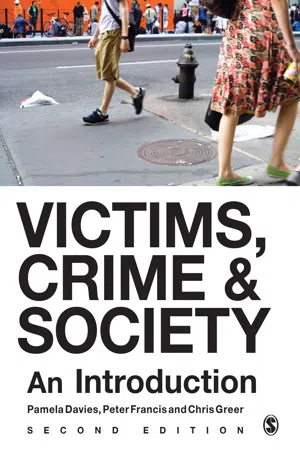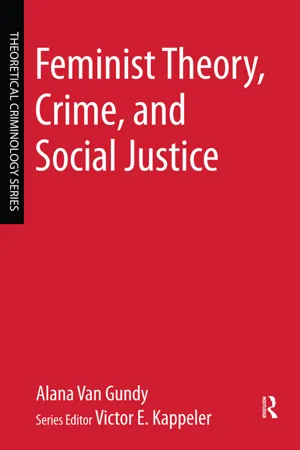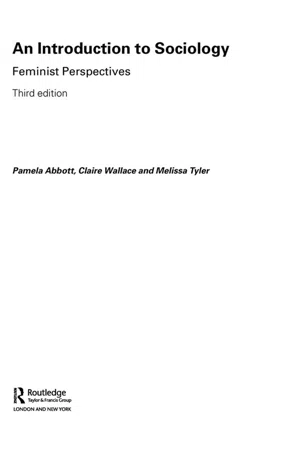Social Sciences
Gender and Crime
Gender and crime refers to the study of how gender influences criminal behavior, victimization, and the criminal justice system. It explores the disparities in crime rates, types of crimes committed, and experiences within the criminal justice system between men and women. This field of study also examines the social construction of gender and its impact on criminal behavior and societal responses to crime.
Written by Perlego with AI-assistance
Related key terms
8 Key excerpts on "Gender and Crime"
- eBook - ePub
Gender, Psychology, and Justice
The Mental Health of Women and Girls in the Legal System
- Corinne C. Datchi, Julie R. Ancis(Authors)
- 2017(Publication Date)
- NYU Press(Publisher)
The American Psychological Association Guidelines for Psychological Practice with Girls and Women (APA 2007) define gender as a multilevel phenomenon: Intrapersonally, gender refers to the cognitive schemas, beliefs, and attitudes that guide individuals’ expression of their social identities in relational contexts. It also refers to the process whereby individuals engage in presentations of self that deviate or conform to gender norms and expectations (Butler 1999, 2004). At a macro-systemic level, gender is a societal structure that determines individuals’ social status and their access to resources, power, and privileges (Ayman and Korabik 2010).The criminological literature has made visible the gendered nature of the criminal justice system. Feminist criminologists and legal scholars have well documented how gender restricts girls’ and women’s access to equitable justice through mechanisms that are evident, tacit, or hidden. They have demonstrated that gender influences the justice system’s responses to female offending and victimization (Belknap 2015; Silvestri and Crowther-Dowey 2008; Sprott, Zimring, and Doob 2009; Wykes and Welsh 2009). They have also identified the pathways that lead to girls’ and women’s involvement with the criminal justice system, as well as the unique challenges girls and women encounter as a result of sexual and physical violence, mental health problems, unmet health-care needs, substance dependence, family responsibilities, and discrimination in employment and education (Belknap 2015; Davies 2011; Morash 2005; Van Gundy and Baumann-Grau 2013).Feminist criminologists and legal scholars have identified the conditions that explain the unprecedented increase in women’s and girls’ arrests and incarceration since the 1970s. These numbers have continued to rise at rates that surpass those of boys and men (Mauer 2013; Minton and Zeng 2015), although the majority of female offenders commit nonviolent crimes that do not represent a risk for public safety (e.g., stealing, running away, violating court orders). Changes in policies—rather than changes in behaviors—explain why increasingly more women and girls are caught up in the net of the criminal justice system (Sprott, Franklin, and Doob 2009; The Sentencing Project 2007). These include the creation of new offenses and sentencing guidelines that have exposed women and girls with a history of victimization and substance abuse to a greater level of justice interventions (Kerig and Ford 2014; Travis, Western, and Redburn 2014). For example, at the peak of the war on drugs, the percentage of women sentenced to prison for drug-related, nonviolent crimes increased by more than 800 percent from 1986 to 1999 (American Civil Liberties Union 2005). The new drug policies of the 1980s and 1990s resulted in women’s criminalization and incarceration for possession, personal use, and street-level sale of illicit substances. Although women’s role in the drug trade was minor compared to that of men, they were subjected to the same mandatory-minimum sentencing laws. - eBook - ePub
Victims, Crime and Society
An Introduction
- Pamela Davies, Peter Francis, Chris Greer(Authors)
- 2017(Publication Date)
- SAGE Publications Ltd(Publisher)
8 Gender, Victims and Crime Pamela Davies The most stable fact about crime in societies across the globe is that it is largely a male activity. Young men in particular are more likely to be convicted of crime than women, have longer criminal careers and commit more serious offences including murder or manslaughter, sexual and violent offences, terrorism, organised, state and corporate crimes. The distinctive male nature of crime warrants explanation and while the gender gap in the commission of crime masks some interesting nuances to the doing of crime by men and women, this feature is stubbornly persistent. Moreover, some crimes are highly gendered in nature. The latter refers to the unequal distribution of victimisation in society and how much interpersonal violence is typically male-on-female. The purpose of this chapter is to encourage critical thinking around gender, victims and crime. First we define gender and explain what a gendered understanding comprises. Key features of the gender patterning to criminal victimisation are outlined and discussed as we explore the nature, extent and impact of victimisation. Vulnerability and victimisation are then considered through a gendered lens. In this discussion the chapter draws especially upon the concepts of secondary victimisation and victim blaming to illustrate how social processes shape victims’ experiences. By examining these processes and illustrating these concepts in the context of criminal justice, the gendered nature of the justice gap is revealed. The emphasis in this chapter is largely on victims of rape, sexual abuse and exploitation. Importantly, the latter allows us to not only move beyond the confines of the criminal justice system, but also to contemplate the intersections of gender and age. Primarily, however, the chapter encourages critical thinking around how a gendered perspective can inform understanding of the social process that give rise to victimisations and what constitutes victimisation - John Muncie, David Wilson(Authors)
- 2013(Publication Date)
- Routledge-Cavendish(Publisher)
Chapter 7 Gender, Crime and Criminal Justice
Sandra WalklateDOI: 10.4324/9781843147008-7Summary
It is now some 45 years ago that Wootton (1959: 32) made the observation that, ‘Yet, if men behaved like women, the courts would be idle and the prisons empty’. Despite the intervening years, some would say that it is still a moot point whether or not criminology, or her sister discipline, victimology, has as yet managed to take Wootton's observation to heart. As Cain (1989 : 4) commented, ‘this is because the criminological gaze cannot see gender: the criminological discourse cannot speak men and women’. Some would say that, current theoretical and empirical agendas notwithstanding, criminology (and victimology; see Chapter 8 ) still struggle with the question of gender (see, for example, Walklate, 2001 ). The purpose of this chapter is to try to unravel some of the issues associated with this perennial disciplinary blindspot. In order to do this, it will first of all introduce the student to the ways in which varieties of feminism have considered this question. It will then consider the different ways in which thinking about men and masculinity can be traced within the discipline. Finally, it will offer a brief overview of how the question of gender may be pertinent in understanding the work of the criminal justice professionals and the formation of criminal justice policy. In doing all of this, the central question of this chapter will be: ‘when is gender the salient variable in facilitating our understanding of crime and criminal justice?’Key Terms
Gender; victimology; feminism – liberal, radical, socialist, postmodern; essentialism; sex role theory; categorical theory; hegemonic masculinity.Sex Or Gender: What Is The Difference?
Braithwaite (1989 : 44) suggests that the first ‘fact’ any theory of crime should fit is that males are disproportionately the offenders. Home Office figures for 2001 showed that 81 per cent of known offenders were male (Home Office, 2002 ). This is a figure that has remained remarkably stable over the last 10 years. Home Office figures provide considerable detail on the differences between men and women in relation to their known offending behaviour, their experience of the criminal justice system and their presence as workers in the criminal justice system. So, for example, in 2001, women sentenced to custody received shorter sentences than men, women made up just over 5 per cent of the prison population, and 42 per cent of women homicide victims, compared with only 4 per cent of men, were killed by a current or former partner (for further information, see Home Office, 2002 ). Before we go on to offer some understanding of these differences, it is important to clarify what they are referring to. These statistics are statistics relating to sex differences, ie differences that can be observed between the biological categories, male and female: they are not necessarily a product of gender. Gender differences are those that result from the socially ascribed roles of being male or being female, ie masculinity and femininity. In order to make this clear, let us return to the first ‘fact’ that Braithwaite comments on. Males are disproportionately the offenders. This ‘fact’ is presented as an observed difference between the sexes. The explanation for this ‘fact’ may lie in the different behaviour of the sexes and the social response to that behaviour (qua Wootton, 1959- eBook - ePub
- Alana Van Gundy(Author)
- 2014(Publication Date)
- Routledge(Publisher)
Masculinities and Crime in which he examined the impact of gender on the social context of criminal definitions and measurement. His work presented an argument that traditional criminological theory was created to explain the majority of crime (male crime) and definitions, measurements, and policies emerged from those male-based concepts. This framework is essentially all that criminology knows and the field is operating under the assumption that females are becoming more violent or are engaging in more “male” forms of crime and evidence male-like thinking patterns and characteristics.Years of research focusing on male delinquency and criminality has resulted in a plethora of literature that widely explains law-violating behavior. Traditional theories have adequately measured involvement in both nonserious property and serious violent crime. In general, the field of criminology has provided validity, reliability, and a deep understanding of the risks for criminal propensity. As females inch closer to the levels of property crime, burglary and larceny, motor vehicle theft, and drug-related crime committed by males, it is argued their behavior mirrors that of males and gender is not an additional risk factor. If current research already explains male behavior, there is no need to create an additional framework or interpret risk factors any differently for females.2.3.1.2 Emergence of a New Violent Offender
Similar to the movement in juvenile crime that focused on the emergence of the juvenile “super-predator,” this explanation argues that women of all ages are becoming more violent. Official crime report statistics show women are being arrested at higher rates for violent crimes such as burglary, larceny, and motor vehicle thefts than they were previously. Both official reports, self-reports and victimization surveys do not confirm this trend with the most violent of crimes— murder and manslaughter; yet, the increasing crime rates in traditional male-like crime typologies have resulted in an outcry by traditional criminologists that there is a rise of new, violent, and dangerous females (Babcock, Miller, & Saird, 2003; Baskin & Sommers, 1998; Bunch, Foley, & Urbina, 1983; Greenfeld & Snell, 1999; Simpson, 1989). This explanation of female criminality also results in the argument that a gender-specific model of criminality is not necessary, as females are simply catching up to the levels of violence demonstrated by male criminals. - eBook - ePub
- Martin Schwartz, Suzanne E. Hatty(Authors)
- 2014(Publication Date)
- Routledge(Publisher)
One theoretical perspective brought to bear on the issue is the analysis of gender as situated accomplishment. From this approach, gender is "much more than a role or individual characteristic: it is a mechanism whereby situated social action contributes to the reproduction of social structure" (West & Fenstermaker, 1995:21). Specifically these theorists argue that women and men "do gender"—or behave in gendered ways—in response to normative beliefs about femininity and masculinity. The performance of gender is a response to gendered social hierarchies and expectations, but it also reproduces and reinforces them. This approach has been incorporated into feminist accounts of crime in order to explain differences in women's and men's offending (Messerschmidt, 1993; Simpson & Elis, 1995). Specifically, crime is described as "a resource' for accomplishing gender—for demonstrating masculinity within a given context or situation" (Simpson & Elis, 1995:50).For example, Messerschmidt (1993) describes robbery as a quintessentially masculine crime, and he argues that men commit robberies as a means of constructing a masculine identity:The robbery setting provides the ideal opportunity to construct an essential' toughness and 'maleness'; it provides a means with which to construct that certain type of masculinity—hardman. Within the social context that ghetto and barrio boys find themselves, then, robbery is a rational practice for 'doing gender' and for getting money(Messerschmidt, 1993:107).Examining crime as masculine accomplishment can help account tor men's greater involvement in particular types of crime, and can help account for women's limited involvement in crime. Facets of this approach also offer useful insights regarding how gendered opportunities shape women's involvement in particular types of crime. For example, cultural definitions of femininity and women's sexuality, coupled with gender stratification on the streets, contribute to the narrowing of women's offending options and help explain women's higher levels of involvement in sex work than other forms of street offending. Nonetheless, the way this theory has been applied to explain male crime is of limited utility in explaining women's offending: it would be difficult to argue, for example, that women engage in street-level sex work as a means of constructing a feminine identity, particularly given the dangers and stigma attached to such activities. Rather, gender helps to narrow those options available to women on the streets, making sex work one of the few money-generating activities open to women (see Maher, 1997). Nonetheless, the concept of "gender accomplishment" remains a useful theoretical explanation for male crime. Even though it is a gendered theory, this does not mean it must be generalizable in its application across gender. - eBook - ePub
Understanding Criminal Behaviour
Psychosocial Perspectives on Criminality and Violence
- David W Jones(Author)
- 2019(Publication Date)
- Routledge(Publisher)
Chapter 6 Gender and Crime Introduction Alongside awareness of the disproportionate numbers of young people offending is the widely accepted fact that men commit more crime than women. Whilst the bald ‘facts’ of the over-representation of men amongst the crime statistics have been known for a long time, they have, however, been largely ‘taken for granted’ (Heidensohn 1996; Messerschmidt 1986). So, the longitudinal studies such as The London Study, reviewed in Chapter 3, studied only boys. The gender bias in criminality was not questioned and there was little interest in studying gender as a significant variable that itself might shed light on the causes of crime. There has, however, been a growth in interest in exploring the implications of the facts of the gender bias in crime since the end of the twentieth century (Jefferson 1997). Can these gender differences tell us something interesting about the cause of crime, or about differences between men and women? Table 6.1 demonstrates the extent of the gender bias in terms in terms of the overall number of arrests for indictable criminal offences in England and Wales. Looking at the overall category of indictable offences (excluding that vague category of ‘other’), there are roughly six arrests of men to every arrest of a woman. There are important differences when various categories of crime are considered - eBook - ePub
An Introduction to Sociology
Feminist Perspectives
- Pamela Abbott, Melissa Tyler, Claire Wallace(Authors)
- 2006(Publication Date)
- Routledge(Publisher)
Social control theory emphasises the ways in which girls and women are controlled within both the public and the private spheres and how they are therefore likely to be more conformist than men. The stereotype of women and a woman’s role plays an important part in explaining the ways in which the control of women is achieved. These assumptions underlie the law governing sexual behaviour, the social benefit system, the interventions of health visitors and the ways in which the criminal justice system handles and disposes of female offenders. The normal woman is seen as a wife and mother who is in need of protection, while the deviant woman is seen as needing to be trained to perform domestic tasks and childcare. However, it is evident that more research needs to be carried out before we can answer the key questions that have been raised concerning women and crime: explanations for the patterning of crime; explanations for why women’s crime differs so much from men’s; and assessment of how far and in what ways gender differences in crime are linked to class, age and race.However, it is clear that explanations which see female crime as a result of a failure of individual women to adapt themselves to their supposedly natural biological role are inadequate and misleading. Women’s behaviour, criminal and non-criminal, needs to be explained by reference to a social formation which imposes restrictive and exploitative roles on women. Furthermore, it must be recognised that in certain economic and ideological circumstances crime may be a rational and coherent response to women’s awareness of the social constraints imposed on them by their social roles and identities.Radical feminist perspectives on crime
Radical feminists have paid more attention to analysing crimes of which women are victims rather than looking at female criminality – that is, to manifestations of male power, and especially to domestic violence, rape, pornography and prostitution. However, a radical feminist account would emphasise patriarchal power relationships and women’s exploitation and subordinate position in examining female crime, emphasising that the locus of male power is sexuality. - eBook - ePub
- Lois Bibbings, Donald Nicolson(Authors)
- 2013(Publication Date)
- Routledge-Cavendish(Publisher)
39 The most honest conclusion seems, therefore, to be that we do not know what the ‘true’ extent of the disparity between male and female crime is, just as we do not know what the true extent of criminal activity is. However, we do know that official statistics portray the criminal activity of the two groups as markedly different. We also know that there is a social perception of gender disparity in criminality, which is centuries old. To what extent have these images affected decision makers? Is there any evidence that they perceive women as less likely to be criminal overall than men? Furthermore, is there any evidence that any difference in perception about the levels of male and female criminality has any impact on whether men and women are caught or charged?Getting caught
The vast majority of known crime is ‘detected’ by members of the public, who interpret an act as criminal and report it to the police. The police only discover a limited amount of criminal activity as a result of investigative techniques of stop and search, surveillance and evidence gathering.40There has been little analysis of the processes by which members of the public conclude that acts and actors are indeed criminal. The few studies that do exist suggest that gender does not play a major part in decisions to report any conduct to the police. Box has argued that the key determinant of a decision to report is offence seriousness, rather than the offender’s gender.41 The British Crime Survey also found that the single largest reason for a failure to report crime is its triviality.42 However, it is difficult to know whether the suspect’s gender affected the perception of offence seriousness and in what ways. As Sanders has argued, ‘store detectives stereotype and, doubtless, ‘ordinary’ members of the public do too’.43
Learn about this page
Index pages curate the most relevant extracts from our library of academic textbooks. They’ve been created using an in-house natural language model (NLM), each adding context and meaning to key research topics.







